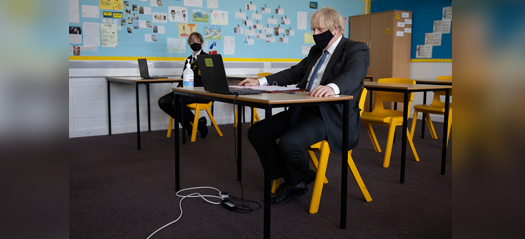
PM Boris Johnson visits the Sedgehill Academy school in Lewisham, London in February.
(Credit: Simon Dawson/No 10 Downing St)
In recent weeks, the number of Covid cases has significantly increased among school-age children, causing more disruption to education. At the start of July, the number of children absent from school in England for Covid-related reasons spiked to around 640,000, raising the question of whether all pupils in a class or ‘bubble’ should be sent home when one student tests positive.
The current rules mean that many children are missing out on weeks of face-to-face teaching after already having missed so much over the past year. Ministers have now said that they want a different system in place in September to curb the disruption to children’s education.
After Prime Minister Boris Johnson announced on July 5 that most remaining Covid restrictions would be lifted on July 19, the next day, Health Secretary, Sajid Javid, announced that starting from August 16, people who have received two doses of the Covid vaccine and children under the age of 18 will no longer have to automatically self-isolate if they come in contact with someone who has tested positive for Covid-19. Instead, people will be advised to get a PCR test to confirm if they are infected.
Confirming the new rulings on July 6, Education Secretary, Gavin Williamson, said that the system of sending “bubbles” of children home after a positive case would also cease on July 19, for most schools, this will be after the end of the summer term.
Williamson said that the system had been necessary to stop the spread of the virus but was now disrupting pupils’ lives.
Schools up and down the country are reporting that the number of children self-isolating due to Covid is at a record high. It has been another year of students missing out on months of face-to-face teaching, and in some cases, children have isolated, returned to school for a short period before being required to isolate again, a system many in education say is untenable.
Data suggest that for every positive case, 20 other pupils on average are being asked to self-isolate for 10 days. It has been particularly bad in recent weeks, and data shows 96 per cent of people self-isolating do not have Covid. As well as pupils, teachers also often have to self-isolate causing all sorts of issues for staffing in schools, with some schools having to close.
It also affects parents who may need to take time off work or organise childcare for younger children. As cases are rising, many schools are being hit by consecutive cases affecting all areas of the school.
With predictions of a rise in Covid cases as restrictions are lifted, and again in the autumn like we saw last year as pupils returned to schools and universities, many are looking towards September and feel the current isolation system needs to be changed and will welcome the Education Secretary’s announcement.
However, with cases raising some health professionals, scientists and teaching unions have warned against the easing of the rules.
So, what will Covid management in schools look like in September? Williamson said that face masks, social distancing measures and staggered start and finish times in schools would be scrapped from September.
Schools will be asked to offer pupils two Covid tests at the beginning of the autumn term, as a one-off event, and then twice weekly testing at home till the end of September.
All school sports and extracurricular activities can resume, as can face-to-face teaching in universities and colleges. Protective measures such as good hygiene and ventilation will also continue until the end of September.
Head Teachers will no longer be responsible for conducting tracing of contacts within schools. This will instead be transferred to the NHS track and trace system. When cases or outbreaks of Covid occur in schools or colleges, they will be contacted by NHS Test and Trace and will work with local health teams to help advise how to manage it.
Not all the details for managing Covid in the new school term in September have been decided, and Williamson has said that more details will follow. For example, pupils are requested to do self-testing at home twice a week using the lateral flow tests.
Whether this will continue after September is unclear, and Williamson has said that this will be reviewed.
Whilst, lateral flow tests are not as accurate as a PCR test, they typically detect between 50-80 per cent of cases and give results in minutes rather than days and are likely to pick out the most infectious cases, thus helping to reduce the spread.
Depending on the number of cases in the country come September, they could provide a useful tool for preventing the spread of Covid, as children remain vaccinated against the disease.
If a child tests positive for Covid, they will be required to stay home and isolate for ten days. As all adults are now eligible for the vaccine, it is hoped that by September most of the teaching and support staff in schools will have been vaccinated, which will help reduce cases in teachers. Currently, there are no plans to vaccinate children.
If the Government decides to start vaccination programmes in children, it will likely start with older, secondary school children.
With restrictions not being lifted till July 19, education settings, parents and pupils will have to get through the rest of this term as best they can and wait to see what the guidelines are in place in September.
Rachel Kayani